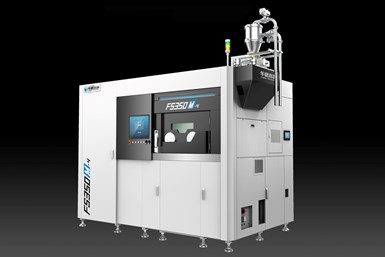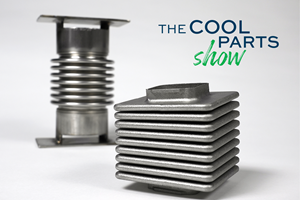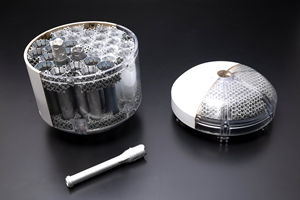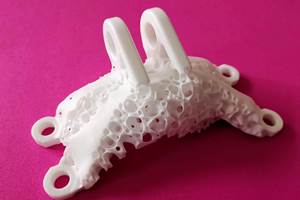Bike Manufacturer Uses Additive Manufacturing to Create Lighter, More Complex, Customized Parts
Titanium bike frame manufacturer Hanglun Technology mixes precision casting with 3D printing to create bikes that offer increased speed and reduced turbulence during long-distance rides, offering a smoother, faster and more efficient cycling experience.
Bicycle enthusiasts have been trying to improve upon the basic bicycle design for more than 200 years. Even today’s basic bicycle template hasn’t changed too much from the rudimentary design of the 1880s, when brakes were finally, and mercifully, added.
Increasingly, both recreational and serious sports cyclists have been looking for bikes that match their unique style, comfort and riding habits — with the days of a standard, one-size-fits-all bike behind us. A bicycle company in China is responding to that market demand by utilizing the design benefits of additive manufacturing (AM) to make lighter, more complex and highly customized bicycle parts — all for a more comfortable ride that offers a better performance and riding experience.
Hi-Light brand bicycle store featuring 10 series and more than 50 models of titanium leisure and sporting bicycles. Metal 3D printing has enabled titanium bike frame manufacturer Hanglun Technology to usher in a new era of sleek, lightweight and fully customizable bikes. Source: Hanglun
Since introducing China’s first titanium alloy bicycle under the “Hi-Light” brand in 1992, Hanglun Technology has grown into one of the world’s largest manufacturers of titanium alloy bikes. With a focus on innovation, it manufactures custom-engineered titanium alloy bike frames, handlebars and other key components, capturing 80% share of the domestic market.
Over the years, titanium bike frame manufacturer Hanglun has been working on the design, development and production of high-end titanium alloy sports bicycle frames, parts and related sports equipment.
The Farsoon FS350M quad-laser metal 3D printing system enables batch production for Hanglun’s Hi-Light bicycle brand. Source: Farsoon
In 2023, Hanglun purchased a Farsoon FS350M quad-laser metal 3D printing system for batch production of its Hi-Light bicycle brand. The company set an ambitious goal to produce more than 50,000 titanium bicycle components annually using this technology, with the components to be used in both high-volume production and custom models around the globe. The focus is on AM driving innovation and efficiencies to deliver titanium alloy parts that offer superior quality, enhanced strength, reduced weight and exceptional durability – all for better performance.
Titanium alloy is known for being lightweight, strong, durable and highly resistant to corrosion, making it a preferred material in industries such as aerospace, automotive, medical devices and consumer electronics. However, the company says that working with titanium can be difficult as its unique structural properties demand precision in every step, especially during welding, which must be executed flawlessly in a single attempt. With little room for error or correction, this level of craftsmanship requires exceptional skill, which can drive up manufacturing costs and, consequently, the final product price.
Since its investment in the Farsoon metal AM system, Hanglun has seen the important advantages of titanium 3D printing technology, including optimized design, rapid prototyping, small batch production, customization and lightweighting.
At present, it uses precision casting in mass production and 3D printing for small-batch customized products, which can take into account the needs of the lightness and weight reduction of cycling products.
Hanglun plans to use 3D printing technology to produce titanium bicycle frames and parts with an annual output of more than 50,000 pieces, which will be applied to a variety of models of bicycles, aiming to provide customers around the world with better quality, higher strength, lighter and more durable titanium bicycle products.
“3D printing is a game-changer in our industry and is leading the way in innovation. It pairs perfectly with traditional precision casting,” says Yanpeng Yang, vice general manager, Hanglun Technology. “Right now, we use precision casting for big production runs and 3D printing for those smaller, custom projects. This mix lets us create lighter, more complex and highly customized bicycle parts. Plus, it helps us cut down on costs and environmental impact for small-batch production, speeds up delivery times, and makes the whole process smoother and more efficient.”
Batch production of titanium bicycle seat stay yokes using the FS350M-4 demonstrates efficiency and innovation. The flat aero tube design of these yokes not only streamlines production but also enhances cycling comfort by reducing the impact of the wheelset on the frame. Source: Hanglun
For instance, batch production of the titanium bicycle seat stay yokes using the FS350M-4 offers efficiency and innovation. In just 24 hours, 38 components are 3D printed, achieving a 60% increase in efficiency compared to traditional casting methods. Also, the flat aero tube design of these yokes not only streamlines production but also enhances cycling comfort by reducing the impact of the wheelset on the frame. This advanced manufacturing approach both speeds up production and contributes to a smoother, more comfortable ride.
AM Benefits Both Manufacturer and Consumer:
Faster Iteration and Time to Market
Traditional manufacturing methods (such as precision casting, CNC machining, wire cutting, welding, correction and surface treatment) involve multiple steps that may drag out production time lines. However, in the product design and development phase, 3D printing can offer a game-changing solution. By enabling rapid iterations of titanium alloy bicycle components, 3D printing significantly speeds up the process, helping brands get products to market faster.
Part Consolidation/Structural Integration
The technology enables the seamless integration of complex structures into a single piece, eliminating the risks often associated with traditional welding, such as deformation, fatigue damage from residual stresses, and issues with size accuracy and poor connections.
Lightweighting
Titanium alloy, with its low density of 4.51 g/cm³ — which is just 60% of the weight of steel — has been a favorite for lightweighting applications. However, traditional welding methods often lead to slightly heavier titanium alloy frames due to the added weight of welding materials. Now, by combining topology optimization with 3D printing technology, users can achieve an impressive reduction in full-frame weight to just 1.4 kg. For cyclists, this means increased speed and reduced turbulence during long-distance rides, offering a smoother, faster and more efficient cycling experience.
Improved Riding Performance
The technology innovations also lead to higher quality, enhanced performance and more reliable components. To further minimize air resistance, Hanglun has integrated cables and components for braking and shifting directly into the 3D printed frame, enhancing overall efficiency.
Component Strength
Hanglun says the Farsoon 3D printed titanium alloy components also demonstrate superior strength and elongation compared to conventionally forged parts. Performance tests on titanium bicycle components produced with the FS350M-4 system are said to reveal exceptional mechanical properties — a tensile strength of 1035 MPa, yield strength of 998 MPa and elongation at break of 13.5%. These enhancements can significantly extend the life span of the components.
Embracing the AM design and manufacturing approach has enabled Hanglun to elevate cycling performance, efficiency and design standards. With a dedication to this continued innovation, Hanglun says it aims to stay at the forefront of the industry, empowering cyclists with the very best in diverse engineering and design.
Related Content
Flexible Bellows Made Through Metal 3D Printing: The Cool Parts Show #64
Can laser powder bed fusion create metal parts with controlled flexibility? We explore an example in this episode of The Cool Parts Show.
Read More3D Printed Lattice for Mars Sample Return Crash Landing: The Cool Parts Show Bonus
NASA Jet Propulsion Laboratory employs laser powder bed fusion additive manufacturing plus chemical etching to create strong, lightweight lattice structures optimized to protect rock samples from Mars during their violent arrival on earth.
Read MoreSpherene Creates Metamaterial with Geometry Derived from Spheres
An algorithm developed by Spherene Inc. generates Adaptive Density Minimal Surfaces (ADMS) as a self-supporting infill strategy that can be used to reduce mass and manage material properties in 3D printed parts.
Read MoreVelo3D Founder on the 3 Biggest Challenges of 3D Printing Metal Parts
Velo3D CEO and founder Benny Buller offers this perspective on cost, qualification and ease of development as they apply to the progress of AM adoption in the future.
Read MoreRead Next
Bike Manufacturer Uses Additive Manufacturing to Create Lighter, More Complex, Customized Parts
Titanium bike frame manufacturer Hanglun Technology mixes precision casting with 3D printing to create bikes that offer increased speed and reduced turbulence during long-distance rides, offering a smoother, faster and more efficient cycling experience.
Read MoreCrushable Lattices: The Lightweight Structures That Will Protect an Interplanetary Payload
NASA uses laser powder bed fusion plus chemical etching to create the lattice forms engineered to keep Mars rocks safe during a crash landing on Earth.
Read More3D Printed Polymer EOAT Increases Safety of Cobots
Contract manufacturer Anubis 3D applies polymer 3D printing processes to manufacture cobot tooling that is lightweight, smooth and safer for human interaction.
Read More

























